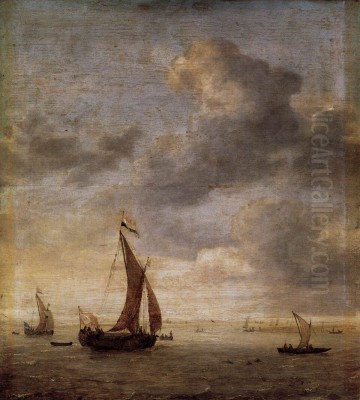
Jan Porcellis stands as a pivotal figure in the evolution of Dutch Golden Age art, particularly renowned for revolutionizing marine painting. Active during the first half of the 17th century, he moved away from the colourful, detailed, and often narrative-driven seascapes of his predecessors towards a more atmospheric and naturalistic approach. His innovative "tonal style," characterized by a restricted palette dominated by greys and browns and a profound sensitivity to light and weather, captured the essence of the sea and sky with unprecedented realism and evocative power. This approach not only defined his own celebrated career but also laid the foundation for subsequent generations of Dutch marine artists.
Early Life and Artistic Formation
Born around 1584 in Ghent, Flanders, Jan Porcellis emerged during a period of significant artistic activity, though the specifics of his earliest training remain somewhat obscure. Ghent, and nearby Antwerp where he likely spent formative years, were vibrant cultural centres. It is widely believed, though definitive documentary proof is scarce, that Porcellis received some instruction from Hendrick Cornelisz. Vroom (c. 1566–1640), the Haarlem-based artist often considered the father of Dutch marine painting. Vroom's work, typically featuring detailed depictions of ships, often engaged in historical naval battles or ceremonial voyages, was characterized by relatively bright colours and a high viewpoint.
Porcellis's early works also show an awareness of the detailed, jewel-like style associated with artists like Jan Brueghel the Elder (1568–1625), known for his meticulous landscapes and allegorical scenes, sometimes incorporating marine elements. However, even if influenced by these masters initially, Porcellis soon embarked on a radically different artistic path. His personal circumstances, including a documented bankruptcy in Rotterdam around 1615, may have coincided with, or perhaps even catalyzed, his stylistic transformation as he moved between cities seeking opportunities.
He is recorded in Antwerp around 1617, where he joined the Guild of Saint Luke, indicating professional recognition. His time in Antwerp placed him in proximity to the dynamic Flemish Baroque, though his developing style would align more closely with the emerging trends in the Northern Netherlands, where he would spend the most productive and influential part of his career.
A New Vision: The Move North and Haarlem
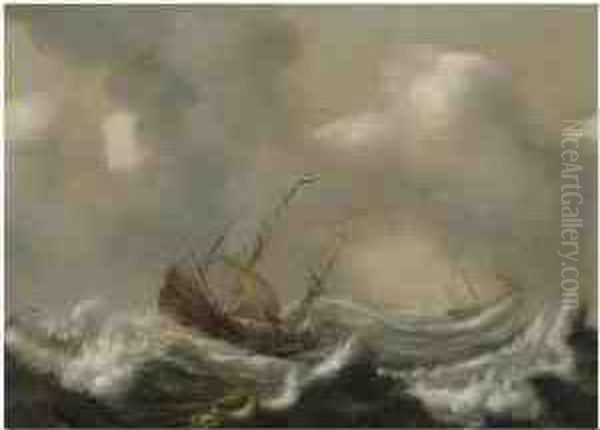
Porcellis's relocation to the Northern Netherlands marked a crucial turning point. He is documented in Rotterdam by 1615, and later, significantly, in Haarlem around 1622. Haarlem in the 1620s was a crucible for innovation in Dutch landscape painting, witnessing the rise of the "tonal phase." Artists like Esaias van de Velde (c. 1587–1630) and, slightly later, Jan van Goyen (1596–1656) and Salomon van Ruysdael (c. 1600/03–1670), were simplifying compositions and adopting monochromatic palettes to capture the specific atmospheric conditions of the Dutch landscape.
It was within this milieu that Porcellis fully developed his signature marine style. He abandoned the high horizons, crowded compositions, and bright, localized colours typical of Vroom and other early marine specialists. Instead, Porcellis lowered the horizon line, dedicating vast portions of his canvases—often two-thirds or more—to the sky. This compositional shift immediately created a greater sense of space and emphasized the overwhelming power and scale of nature relative to human endeavours.
His focus shifted from depicting specific events or meticulously rendering ship details to capturing the feeling of being at sea: the damp air, the changing light, the movement of water and clouds. This represented a fundamental conceptual shift in marine painting, moving from documentation and decoration towards atmospheric evocation and a more profound engagement with the natural world.
The Essence of Porcellis: The Tonal Style
The hallmark of Jan Porcellis's mature work is his mastery of the tonal style. He achieved his effects through a deliberately restricted palette, relying heavily on subtle gradations of grey, silver, brown, and muted blues and greens. Colour was used sparingly, often serving to accentuate the overall atmospheric unity rather than describe individual objects in detail. This near-monochromatic approach allowed him to focus intently on light, shadow, and value contrasts.
Porcellis excelled at depicting the interplay between water and sky under various weather conditions. He rendered churning waves with dynamic, fluid brushwork, capturing the texture of foam and spray. His skies are masterpieces of observation, showing clouds massing before a storm, light breaking through after rain, or the hazy diffusion of sunlight on a calm day. He understood how light reflects off water and filters through moist air, unifying the elements of sea, sky, and ships into a cohesive, believable whole.
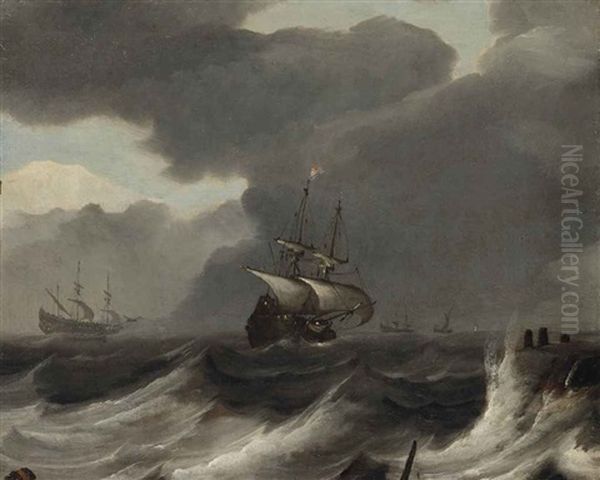
Unlike the often static arrangements in earlier marine art, Porcellis's paintings convey a sense of immediacy and movement. Ships feel genuinely subject to the forces of wind and water, heeling in the breeze or battling through rough seas. He often depicted smaller, common vessels like fishing boats or coastal barges, rather than exclusively focusing on large warships or East Indiamen, bringing a sense of everyday reality to his maritime scenes. This focus on atmosphere and common maritime life, rendered with sophisticated simplicity, was revolutionary.
Masterpieces of Atmosphere
Several key works exemplify Porcellis's artistic achievements. Ships in a Storm (or Ships in a Gale), dating from his mature period (versions exist, e.g., c. 1628-1630), is a powerful demonstration of his ability to convey the drama of rough weather. The composition is dominated by a turbulent sky and dark, menacing waves. Small vessels struggle against the elements, their vulnerability emphasized by the vastness of the sea and sky. Light dramatically breaks through the clouds, highlighting the cresting foam and the wet surfaces of the ships, creating focal points within the largely grey and brown palette. The painting is less about the ships themselves and more about the overwhelming power of nature.
Another significant work, sometimes titled Shipping off the Coast of Vlieland and Terschelling, showcases his skill in rendering calmer, though still atmospheric, conditions. Such paintings often feature a low horizon, expansive sky filled with subtly modulated clouds, and reflections shimmering on the water's surface. Ships are placed carefully within the composition to create depth and balance, their sails catching the gentle breeze. These works demonstrate Porcellis's versatility in capturing different moods of the sea.
A Shipping Scene, like many of his works, might depict various vessels near a coastline or in an estuary. These scenes often focus on the effects of light and air, with distant elements dissolving into the haze. The emphasis is on the overall harmony and the convincing portrayal of space and atmosphere, achieved through masterful tonal control and economical brushwork. His ability to suggest detail without laboriously rendering it was a key aspect of his genius.
A Life of Movement and Work
Porcellis's career involved considerable movement. After his time in Haarlem, he is recorded in Amsterdam (by 1624) and Voorburg, near The Hague (around 1626). He eventually settled in Zoeterwoude, a village near Leiden, where he died in January 1632. Despite documented financial difficulties earlier in his life, particularly the Rotterdam bankruptcy, his reputation grew substantially, and his works became highly sought after.
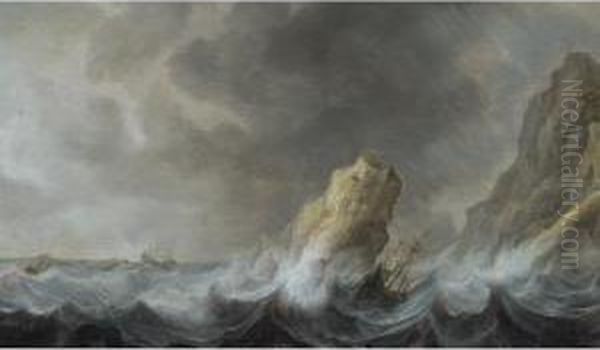
He was remarkably prolific, and his paintings varied in size. While capable of larger canvases, he also produced many smaller panels, known as cabinet pictures, which were popular for display in the homes of Dutch burghers. The demand for his work suggests considerable success in the burgeoning Dutch art market. His paintings were appreciated not just for their innovative style but also for their evocative beauty and convincing naturalism.
His influence was such that his works were collected by prominent individuals, including fellow artists. Notably, the inventories of both Rembrandt van Rijn (1606–1669) and the landscape painter Pieter de Molijn (1595–1661) listed paintings by Porcellis, indicating the high esteem in which he was held by his peers. The renowned marine painter Jan van de Capelle (1626–1679) was also a major collector of Porcellis's work, owning numerous paintings and drawings.
Porcellis and His Contemporaries
Porcellis's relationship with Hendrick Vroom represents a classic instance of a pupil diverging significantly from his master's style, ultimately eclipsing him in terms of innovation and long-term influence on the genre. While Vroom laid the groundwork for marine painting as an independent genre in the Netherlands, Porcellis redefined its aesthetic possibilities.
His connection with the Haarlem tonal landscape painters like van Goyen and Salomon van Ruysdael is crucial. While they focused on land, Porcellis applied similar principles of tonal unity and atmospheric sensitivity to the sea. There was likely mutual influence among these artists working in Haarlem during the 1620s, collectively pushing Dutch painting towards greater naturalism.
The fact that artists of the stature of Rembrandt and collectors like van de Capelle acquired his work underscores his importance. It suggests his art resonated deeply within the artistic community, recognized for its quality and groundbreaking nature. There is also mention of a possible collaboration or connection with an Amsterdam marine painter named Anthonisz., who may have been his brother-in-law, though details remain unclear. This points to the network of relationships within the art world of the time.
The Porcellis Legacy: Influence and Followers
Jan Porcellis's impact on the course of Dutch marine painting was profound and immediate. He is widely regarded as the most influential marine painter of the first half of the 17th century. His tonal approach became the dominant style for a generation.
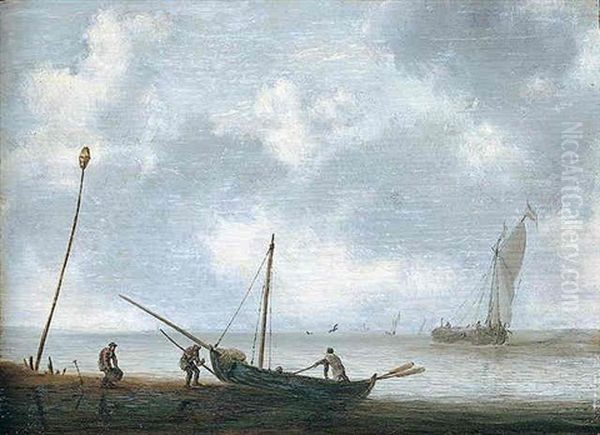
Perhaps his most significant follower was Simon de Vlieger (c. 1601–1653). De Vlieger initially worked very much in Porcellis's manner, adopting the grey palette and atmospheric focus. Over time, de Vlieger gradually introduced more colour and clarity into his work, paving the way for the next phase of Dutch marine painting, but his foundations were firmly rooted in Porcellis's innovations.
Porcellis's influence extended to the next generation's leading marine artists, Willem van de Velde the Elder (1611–1693) and his son, Willem van de Velde the Younger (1633–1707). While the younger van de Velde, particularly, moved towards greater detail and often brighter light (influenced also by de Vlieger), the sensitivity to atmosphere and light effects pioneered by Porcellis remained a fundamental element of their work.
Other artists clearly indebted to Porcellis include Jan van de Capelle, who specialized in serene, calm seascapes that owe much to Porcellis's handling of light and water, albeit often with a cooler palette. Allart van Everdingen (1621–1675), known primarily for his Scandinavian landscapes, also painted seascapes influenced by Porcellis's tonalism. Lesser-known marine specialists, such as Pieter Mulier I (c. 1610-1659), also worked in his style.
Furthermore, his son, Julius Porcellis (c. 1610–1654), became a marine painter in his own right. Julius worked so closely in his father's style that distinguishing between their works remains a significant challenge for art historians, complicating attributions even today. This close stylistic similarity testifies to the strength and directness of the artistic inheritance within the family.
Challenges and Recognition
Despite his eventual artistic success and influence, Porcellis's life included periods of financial instability, as evidenced by his bankruptcy. This contrast between artistic innovation and personal economic challenges was not uncommon for artists of the period. However, his reputation seems to have been consistently high among connoisseurs and fellow artists.
The nickname "Raphael of marine painting," though perhaps apocryphal or a later embellishment, suggests the level of esteem he attained, comparing his mastery within his genre to that of the High Renaissance master. His works commanded respectable prices, and the sheer number of surviving paintings and contemporary copies attests to his popularity.
Attribution issues, particularly distinguishing his work from that of his son Julius and other close followers or imitators, remain a challenge for scholarship. This is, in part, a testament to the pervasive influence of his style. The very success of his tonal approach meant that many artists adopted it, sometimes making definitive authorship difficult to determine without clear signatures or provenance.
Rediscoveries and Enduring Mysteries
Art historical research continues to shed light on Porcellis's oeuvre. Occasionally, previously unknown or misattributed works surface, offering new insights into his development or range. The discovery or reattribution of works like a Stormy Harbour Scene adds to the corpus and helps refine our understanding of his artistic practice.
The precise nature of his early training, the exact chronology of his movements, and the full extent of his workshop practices (if any) remain areas where details are scarce. The difficulty in separating his late works from the early works of his son Julius is perhaps the most persistent conundrum surrounding his legacy.
However, these lingering questions do not diminish his stature. Jan Porcellis remains a key innovator in Dutch art. He fundamentally shifted the focus of marine painting from narrative and topographical detail towards the expressive power of atmosphere, light, and the raw elements of nature.
Conclusion: A Lasting Impression on Marine Art
Jan Porcellis was more than just a painter of ships; he was a poet of the sea and sky. His revolutionary tonal style captured the unique atmospheric conditions of the Dutch coast and estuaries with unparalleled sensitivity. By prioritizing mood, light, and naturalism over colourful decoration and intricate detail, he transformed marine painting into a vehicle for profound emotional and sensory experience. His influence permeated the work of the best marine painters who followed, including Simon de Vlieger, Jan van de Capelle, and the van de Veldes, ensuring his legacy as one of the true masters of the Dutch Golden Age and a foundational figure in the history of European marine art. His evocative grey-toned seascapes continue to resonate with viewers today, testaments to his enduring vision.